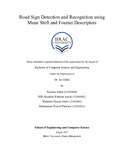| dc.contributor.advisor | Uddin, Dr. Jia | |
| dc.contributor.author | Sakib, Nazmus | |
| dc.contributor.author | Aunik, MD. Moshiur Rahman | |
| dc.contributor.author | Sabit, Mahmud Hassan | |
| dc.contributor.author | Patwary, Mohammad Towsif | |
| dc.date.accessioned | 2018-01-02T04:48:16Z | |
| dc.date.available | 2018-01-02T04:48:16Z | |
| dc.date.copyright | 2017 | |
| dc.date.issued | 2017-08 | |
| dc.identifier.other | ID 13101069 | |
| dc.identifier.other | ID 12201082 | |
| dc.identifier.other | ID 13101065 | |
| dc.identifier.other | ID 12301021 | |
| dc.identifier.uri | http://hdl.handle.net/10361/8843 | |
| dc.description | This thesis report is submitted in partial fulfillment of the requirements for the degree of Bachelor of Science in Computer Science and Engineering, 2017. | en_US |
| dc.description | Cataloged from PDF version of thesis report. | |
| dc.description | Includes bibliographical references (page 29-31). | |
| dc.description.abstract | This paper presents an automated system for road sign detection and shape recognition based on geometric attribute and color information of the road sign. Road sign detection and recognition technique is important to support a driver. It can be the part of autonomous vehicles or road sign maintenance system to maintain processing and time efficiency. This technique determines road sign information and its exact position. Failure detection by the driver of any traffic sign may increase accident risk significantly. It still have some performance limitations though it has been studied for many years. The proposed system consists of three steps: (1) The initial RGB image taken from a camera is pre-processed using Mean Shift clustering algorithm. The clustering technique determines the color information, (2) In order to discard non-interest regions the clustered image is post-processed using a random forest classifier to segment the clustered image, (3) A shape based classification is performed using Fourier Descriptors and SVM’s. The proposed method is applied on both German Traffic Sign Detection Benchmark and Swedish Traffic Signs Datasets. It yields to satisfactory results when compared with other shape recognition process using machine learning technique and some state-of-the-art technique. Experiments with both German and Swedish datasets where RGB images are captured with different cameras yielded a sign detection ration between 95% and 97% and the false alarm ration between 5% and 3%. The rate of the detection depends on the size of the database. | en_US |
| dc.description.statementofresponsibility | Nazmus Sakib | |
| dc.description.statementofresponsibility | MD. Moshiur Rahman Aunik | |
| dc.description.statementofresponsibility | Mahmud Hassan Sabit | |
| dc.description.statementofresponsibility | Mohammad Towsif Patwary | |
| dc.format.extent | 31 pages | |
| dc.language.iso | en | en_US |
| dc.publisher | BRAC University | en_US |
| dc.rights | BRAC University thesis are protected by copyright. They may be viewed from this source for any purpose, but reproduction or distribution in any format is prohibited without written permission. | |
| dc.subject | Road sign detection | en_US |
| dc.subject | Shape recognition | en_US |
| dc.subject | Geometric attribute | en_US |
| dc.subject | RGB image | en_US |
| dc.subject | Mean shift | en_US |
| dc.subject | Fourier descriptors | en_US |
| dc.title | Road sign detection and recognition using mean shift and fourier descriptors | en_US |
| dc.contributor.department | Department of Computer Science and Engineering, BRAC University | |
| dc.description.degree | B. Computer Science and Engineering
| |

